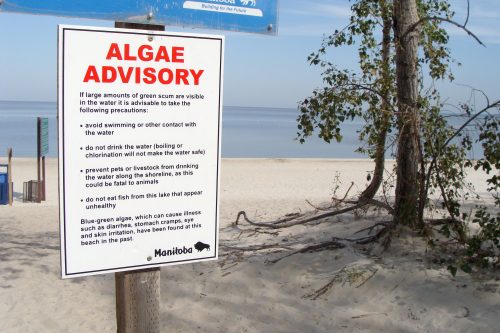When lake waters become stagnant and are exposed to extended periods of hot weather, conditions for blue-green algae to bloom in the lake become more likely, according to Tracy Scott, Provincial Head of Industry and Government Relations for Ducks Unlimited Canada.
With the very hot conditions Alberta has faced this summer, lots of lakes around Alberta have already been marked with bloom advisories from Alberta Health Services. Those lakes include Pigeon Lake, Lac Ste. Anne, Lac La Biche, and 42 other lakes around the province.

Algae warning sign in Grand Beach, Manitoba. Photo from Ducks Unlimited Canada.
Scott spoke to CFWE in an interview about blue-green algae, describing it as "a group of microscopic organisms known as cyanobacteria. They are present in virtually all waterbodies."
Cyanobacteria has the ability to create instant flu-like symptoms and can be worse on someone with pre-existing health conditions. It can also be lethal to animals, both pets and to the surrounding ecosystem in and around the affected lake. Scott says that the best way for people to stay safe is "to not drink the water or swim in it."
More favorable conditions for algae blooms include shallow waters and lots of excess nutrients from surrounding land, Scott said.
"That's a typical Alberta lake, so it's not uncommon for blue-green algae blooms to appear throughout the province, especially at this time of year," he added.
With this summer seeing lots of hot weather, as well as sporadic heavy rainfall, those conditions have left plenty of time and resources for blue-green algae blooms to plague lakes around the province. The warm weather allows the cyanobacteria to thrive, and the rainfall feeds it to grow into big algae blooms.
Blue-green algae blooms aren't something that can be fixed quickly, but according to Scott, managing the lakes overland intake can help reduce the possibility of a bloom in the future.
"The best long-term response to excess nutrients is a well-managed watershed. Most lakes in Alberta are what are known as 'prairie fed lakes,' which means they are fed strictly through overland flow...what that means is that all of that water that's running off of the convening watershed picks up nutrients and pollutants and more contaminants that will eventually end up in the lakes. If you manage your watershed properly...you can effectively capture, store, and treat a lot of that nutrient load that would eventually end up in the lake," Scott said.
Listen to the full CFWE interview with Tracy Scott below:


